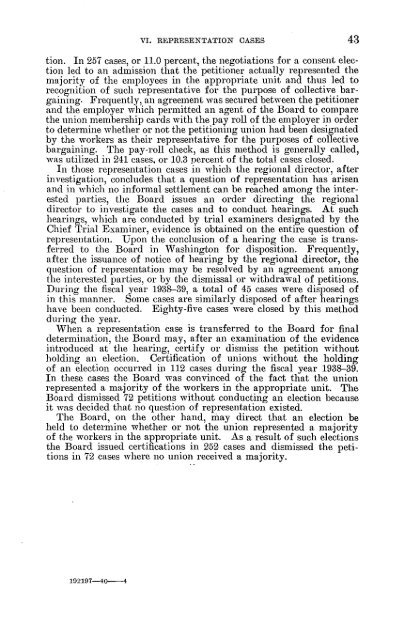J. - National Labor Relations Board
J. - National Labor Relations Board
J. - National Labor Relations Board
- No tags were found...
You also want an ePaper? Increase the reach of your titles
YUMPU automatically turns print PDFs into web optimized ePapers that Google loves.
VI. REPRESENTATION CASES 43tion. In 257 cases, or 11.0 percent, the negotiations for a consent electionled to an admission that the petitioner actually represented themajority of the employees in the appropriate unit and thus led torecognition of such representative for the purpose of collective bargaining.Frequently, an agreement was secured between the petitionerand the employer which permitted an agent of the <strong>Board</strong> to comparethe union membership cards with the pay roll of the employer in orderto determine whether or not the petitioning union had been designatedby the workers as their representative for the purposes of collectivebargaining. The pay-roll check, as this method is generally called,was utilized in 241 cases, or 10.3 percent of the total cases closed.In those representation cases in which the regional director, afterinvestigation, concludes that a question of representation has arisenand in which no informal settlement can be reached among the interestedparties, the <strong>Board</strong> issues an order directing the regionaldirector to investigate the cases and to conduct hearings. At suchbearings, which are conducted by trial examiners designated by theChief Trial Examiner, evidence is obtained on the entire question ofrepresentation. Upon the conclusion of a hearing the case is transferredto the <strong>Board</strong> in Washington for disposition. Frequently,after the issuance of notice of hearing by the regional director, thequestion of representation may be resolved by an agreement amongthe interested parties, or by the dismissal or withdrawal of petitions.During the fiscal year 1938-39, a total of 45 cases were disposed ofin this manner. Some cases are similarly disposed of after hearingshave been conducted. Eighty-five cases were closed by this methodduring the year.When a representation case is transferred to the <strong>Board</strong> for finaldetermination, the <strong>Board</strong> may, after an examination of the evidenceintroduced at the hearing, certify or dismiss the petition withoutholding an election. Certification of unions without the holdingof an election occurred in 112 cases during the fiscal year 1938-39.In these cases the <strong>Board</strong> was convinced of the fact that the unionrepresented a majority of the workers in the appropriate unit. The<strong>Board</strong> dismissed 72 petitions without conducting an election becauseit was decided that no question of representation existed.The <strong>Board</strong>, on the other hand, May direct that an election beheld to determine whether or not the union represented a majorityof the workers in the appropriate unit. As a result of such electionsthe <strong>Board</strong> issued certifications in 252 cases and dismissed the petitionsin 72 cases where no union received a majority.192197-40-----4
















